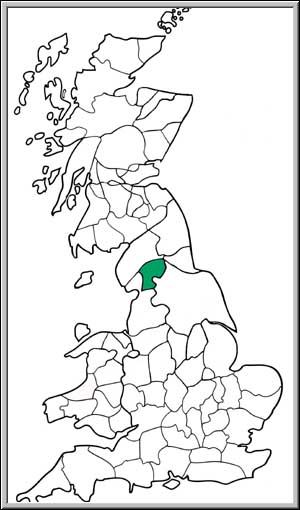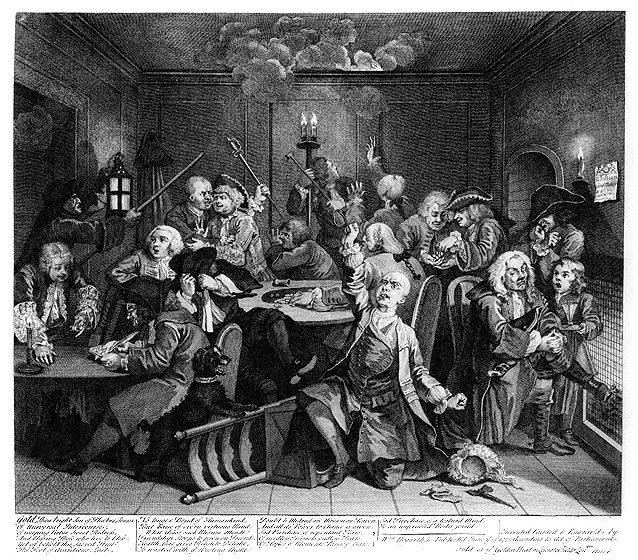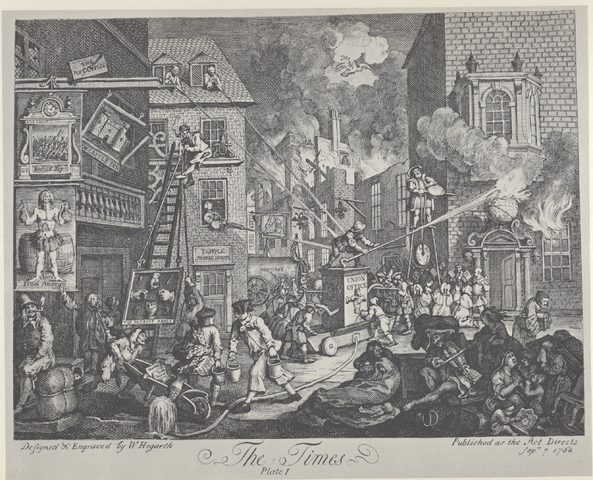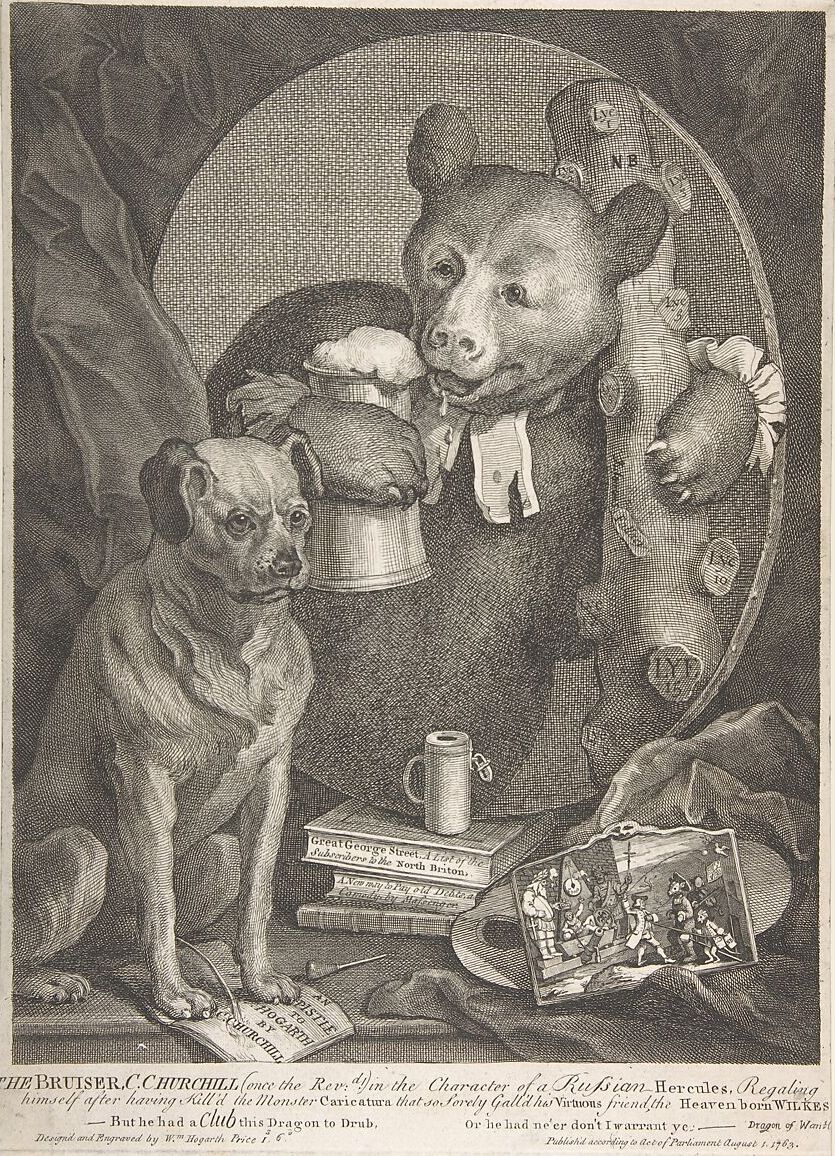William Hogarth (1697-1764)
William Hogarth is one of the most famous of all English artists. For the story of his life, here is the biography taken from the first volume of John Nichols / George Steevens, The Genuine Works of William Hogarth (1808) and other sources:

The Life of Hogarth
[WILLIAM HOGARTH] is said . . . to have been the descendant of a family originally from Kirby Thore, in Westmorland. His grandfather was a plain yeoman, who possessed a small tenement in the vale of Bampton, a village about fifteen miles north of Kendal, in that county; and had three sons. The eldest assisted his father in farming, and succeeded to his little freehold. The second settled in Troutbeck, a village eight miles north-west of Kendal, and was remarkable for his talent at provincial poetry. . . .

RICHARD HOGARTH, the third son, who was educated at St. Bee's, and had kept a school in the same county, appears to have been a man of some learning. He came early to London, where he resumed his original occupation of a schoolmaster, in Ship Court in The Old Bailey, and was occasionally employed as a corrector of the press. . . .
Mr. Richard Hogarth married in London; and our artist, and his sisters Mary and Anne, are believed to have been the only products of the marriage.
Hogart was the family name, probably a corruption of Hogherd, for the latter is more like the local pronunciation than this first. This name disgusted Mrs. Hogart; and before the birth of her son, she prevailed upon her husband to liquify it into Hogarth. This circumstance was told to me by Mr. Walker, who was a native of Westmorland. By the late Dr. Morell I was also informed, that his real Name was Hoggard, or Hogard, which himself altered, by changing d into . . . th. WILLIAM HOGARTH was born November 10, and baptised Nov. 28, 1697, in the parish of St. Bartholomew the Great, in London; to which parish, it is said, in the Biographia Britannica, he was afterwards a benefactor . . .
The school of Hogarth's father, in 1712, was in the parish of St. Martin, Ludgate. In the register of that parish, therefore, the date of his death, it was natural to suppose, might be found; but the register has been searched to no purpose. . . .
Hogarth seems to have received no other education than that of a mechanic, and his outset in life was unpropitious. Young Hogarth was bound apprentice to Ellis Gamble, a silversmith of some eminence; by whom he was confined to that branch of the trade which consists in engraving arms and ciphers upon the plate. While thus employed, he gradually acquired some knowledge of drawing; and before his apprenticeship expired, he exhibited talent for caricature.
"But, before his time was expired, he felt the impulse of genius, and that it directed him to painting."From words they soon got to blows, and the quart pots being the only missiles at hand, were sent flying about the room in glorious confusion. This was a scene too laughable for Hogarth to resist.
During his apprenticeship, he set out one Sunday, with two or three companions, on an excursion to Highgate. The weather being hot, they went into a public house; where they had not long been, before a quarrel arose between some persons in the same room. . . .He drew out his pencil, and produced on the spot one of the most ludicrous figures that ever was seen. ... [This piece] exhibited an exact likeness of the man, with the portrait of his antagonist, and the figures in caricature in the principal persons gathered round him. . . .On the expiration of his apprenticeship, says Horace Walpole,"he entered into the academy in St. Martin's-lane, and studied drawing from the life, in which he never attained to great excellence. It was character, the passions, the soul, that his genius was given him to copy. In colouring he proved no greater a master: his force lay in expression, not tints and chiaro scuro." . . .
The engraving of arms and shop-bills seems to have been his first employment by which to obtain a decent livelihood. He was, however, soon engaged in decorating books, and furnished sets of plates for several publications of the time. An edition of Hudibras afforded him the first subject suited to his genius yet he felt so much the shackles of other men's ideas, that he was less successful in this task than might have been expected. In the meantime, he had acquired the use of the brush, as well as of the pen and graver; and possessing a singular facility in seizing a likeness, he acquired considerable employment as a portrait painter. Shortly after his marriage in 1729, he informs us that he commenced painter of small conversation pieces, from twelve to fifteen inches in height; the novelty of which caused them to succeed for a few years. One of the earliest productions of this kind,
in which he distinguished himself as a Painter, is supposed to have been a representation of Wanstead Assembly. In this are introduced portraits of the first earl Tylney, his lady, their children, tenants, &c.The figures in it were drawn from the life, and without burlesque. The faces were said to bear great likenesses to the persons so drawn, and to be rather better coloured than some of his more finished performances. Grace, however, was no attribute of his pencil; and he was more disposed to aggravate, than to soften the harsh touches of nature.A curious anecdote is recorded of our artist during the early part of his practice as a portrait painter:
a Nobleman, who was uncommonly ugly and deformed, came to sit to him for his picture. It was executed with a skill that did honour to the Artist's abilities; but the likeness was rigidly observed, without even the necessary attention to compliment or flattery. The Peer, disgusted at this counterpart of his dear self, never once thought of paying for a reflector that would only insult him with his deformities.After some time had elapsed, and numerous unsuccessful applications had been made for payment, the painter resorted to an expedient, which he knew must alarm the nobleman's pride. He sent him the following card:"Mr. Hogarth's dutiful respects to Lord — Finding that he does not mean to have the picture which was drawn for him, is informed again of Mr. Hogarth's necessity for the money. If, therefore, his lordship does not send for it in three days, it will be disposed of, with the addition of a tail and some other appendages, to Mr. Hare, the famous wild-beast man; Mr. Hogarth having given that gentleman a conditional promise of it for an exhibition-picture, on his lordship's refusal."
This intimation had its desired effect. The picture was sent home, and committed to the flames.Hogarth's talents, however, for original comic design, gradually unfolded themselves, and various public occasions produced displays of his ludicrous powers.
In the year 1729, he clandestinely married the only daughter of Sir James Thornhill, the painter, who was not easily reconciled to her union with an obscure artist, as Hogarth then comparatively was. Shortly after, he commenced his first great series of moral paintings, "The Harlot's Progress:" some of these were, at Lady Thornhill's suggestion, designedly placed by Mrs. Hogarth in her father's way, in order to reconcile him to her marriage. Being informed by whom they were executed, Sir James cried out,
"Very well; the man who can furnish representations like these, can also maintain a wife without a portion!"He soon after, however, relented, and became generous to the young couple, with whom he lived in great harmony until his death, which took place in 1734.
 In 1733 Hogarth's genius became conspicuously known. The third scene of his Harlot’s Progress introduced him to the notice of the great. At a Board of Treasury, which was held a day or two after the appearance of that print, a copy of it was shewn by one of the Lords, as containing, among other excellences, a striking likeness of Sir John Gonson [a celebrated magistrate of that day, well known for his rigour towards women of the town]. It gave universal satisfaction; from the Treasury each Lord repaired to the print-shop for a copy of it, and Hogarth rose completely into fame.
In 1733 Hogarth's genius became conspicuously known. The third scene of his Harlot’s Progress introduced him to the notice of the great. At a Board of Treasury, which was held a day or two after the appearance of that print, a copy of it was shewn by one of the Lords, as containing, among other excellences, a striking likeness of Sir John Gonson [a celebrated magistrate of that day, well known for his rigour towards women of the town]. It gave universal satisfaction; from the Treasury each Lord repaired to the print-shop for a copy of it, and Hogarth rose completely into fame.Upwards of twelve hundred subscribers entered their names for the plates, which were copied and imitated on fan mounts, and in a variety of other forms; and a pantomime taken from them was represented at the theatre. This performance, together with several subsequent ones of a similar kind, have placed Hogarth in the rare class of original geniuses and inventors. He himself claimed to have created an entirely new species of "painting and engraving modern moral subjects"; and he may be considered rather as a writer of comedy with a pencil, than as a painter. If catching the manners and follies of an age, living as they rise, — if general satire on vices, — and ridicule familiarized by strokes of Nature, and heightened by wit, — and the whole animated by proper and just expressions of the passions, — be comedy, Hogarth composed comedies as much as Moliere.
Soon after his marriage, Hogarth had summer-lodgings at South Lambeth; and being intimate with Mr. Tyers [the then spirited proprietor of Vauxhall Gardens], contributed to the improvement of The Spring Gardens at Vauxhall, by the hint of embellishing them with paintings, some of which were the suggestions of his own truly-comic pencil. Among these were the "Four parts of the Day," copied by Hayman from the designs of our Artist.

Two years after the publication of his Harlot’s Progress, appeared the Rake's Progress, which
"had not," Mr. Walpole observes, "so much success, for want of novelty; nor indeed is the print of the Arrest equal in merit to the others." . . . "The curtain," adds Mr. Walpole, "was now drawn aside, and his genius stood displayed in its full lustre."The Rake's Progress was followed by several works in series, viz. Marriage a la Mode, Industry and Idleness, the Four Stages of Cruelty, and the Election Prints. To these may be added a great number of single comic pieces, all of which present a rich source of amusement:— such as The March to Finchley, the Midnight Modern Conversation, the Sleeping Congregation, the Gate of Calais, Gin Lane and Beer Street, Strolling Actresses Dressing in a Barn, the Lecture, the Laughing Audience, the Enraged Musician, &c. &c. All the works of this original genius are, in fact, lectures of morality. They are satires of particular vices and follies, expressed with such strength of character and such an accumulation of minute and appropriate circumstances, that they have all the truth of nature heightened with the attractions of wit and fancy. Nothing is without a meaning, but all either conspires to the great end, or forms an addition to the lively drama of human manners. His single pieces, however, are rather to be considered as studies, not perhaps for the professional artist, but for the searcher into life and manners and for the votaries of true humour and ridicule. No furniture of the kind can vie with Hogarth's prints, as a fund of inexhaustible amusement, yet conveying at the same time lessons of morality.
Not contented, however, with the just reputation which he had acquired in his proper department, Hogarth attempted to shine in the highest branch of the art — serious history painting.
"From a contempt of the ignorant Virtuosi of the age," says Mr. Walpole, "and from indignation at the impudent tricks of Picture-dealers, whom he saw continually recommending and vending vile copies to Bubble-collectors; and from having never studied, or indeed having seen, few good Pictures of the great Italian Masters; he persuaded himself that the praises bestowed on those glorious works were nothing but the effects of prejudice. He talked this language till he believed it; and having heard it often asserted, as is true, that Time gives a mellowness to colours and improves them, he not only denied the proposition, but maintained that Pictures only grew black and worse by age, not distinguishing between the degrees in which the proposition might be true or false. He went farther: he determined to rival the Antients — and unfortunately chose one of the finest Pictures in England as the object of his competition. This was the celebrated Sigismunda of Sir Luke Schaub, now in the possession of the Duke of Newcastle, said to be painted by Correggio, probably by Furino, but no matter by whom. It is impossible to see the Picture, or read Dryden's inimitable Tale, and not feel that the same soul animated both. After many essays, Hogarth at last produced HIS Sigismunda, — but no more like Sigismunda, than I to Hercules. Not to mention the wretchedness of the colouring, it was the representation of a maudlin strumpet just turned out of keeping, and, with eyes red with rage and usquebaugh, tearing off the ornaments her keeper had given her."

Notwithstanding Hogarth professed to decry literature, he felt an inclination to communicate to the public his ideas, on a topic connected with his art. His Analysis of Beauty made its appearance in one volume quarto, in the year 1753. Its leading principle is that beauty fundamentally consists in that union of uniformity which is found in the curve or waving line; and that round swelling figures are most pleasing to the eye. This principle he illustrates by many ingenious remarks and examples, and also by some plates characteristic of his genius.
In the year 1757, his brother-in-law, Mr. Thornhill, resigned his office of king's serjeant-painter in favour of Hogarth, who received his appointment on the 6th of June, and entered on his functions on the 16th of July, both in the same year. This place was re-granted to him by a warrant of George the Third, which bears date the 30th October, 1761, with a salary of ten pounds per annum, payable quarterly.
This connection with the court probably induced Hogarth to deviate from the strict line of party neutrality which he had hitherto observed, and to engage against John Wilkes and his friends, in a print published in September, 1762, entitled The Times. This publication provoked some severe strictures from Wilkes's pen in The North Briton No. 17. Hogarth replied by a caricature of the writer: a rejoinder was put in by Charles Churchill, in an angry Epistle to Hogarth (not the brightest of his works): and in which the severest strokes fell on a defect the painter bad not caused, and could not amend — his age; which, however, was neither remarkable nor decrepit; much less had it impaired his talents for, only six months before, he had produced one of his most capital works. In revenge for this Epistle, Hogarth caricatured Churchill, under the form of a canonical bear, with a club and a pot of porter.
During this period of warfare (so virulent and disgraceful to all the parties), Hogarth's health visibly declined.
About the end of the year 1762 he complained of an inward pain, which, continuing, brought on a general decay, that proved incurable.On the 25th of October, 1764 (having been previously conveyed in a very weak and languid state from Chiswick to Leicester Fields), he died suddenly, of an aneurism in his chest. His remains were interred at Chiswick, beneath a plain but neat mausoleum, with the following elegant inscription by his friend Garrick:"Farewell, great painter of mankind,
Who reach'd the noblest point of art;
Whose pictured morals charm the mind,
And through the eye correct the heart.
If Genius fire thee, reader, stay;
If Nature touch thee, drop a tear:
If neither move thee, turn away,
For Hogarth's honour'd dust lies here."For more details, see The Site for Research on William Hogarth.
